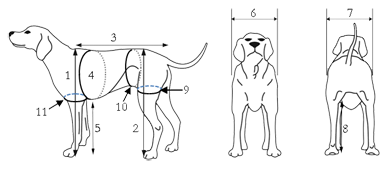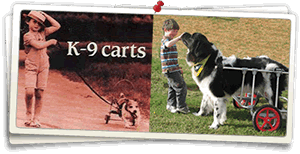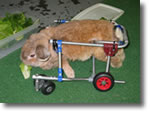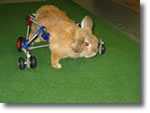Evaluating Your Pet
General Info
The general need for a K9 cart is almost always related to partial or total loss of nerve function to a limb. Other indications include: amputation or congenital defects resulting in limb loss, rehabilitation therapy to minimize weight bearing following surgery, or traumatic injury. Of course, there are many limited other reasons why your pet may have a special need for a cart. Please contact us to discuss these special needs. The following criteria are also important to consider in evaluating your pet for successful use of our standard two-wheeled cart. Click here for additional information on:
- Cats,
- Rabbits, and
- Other Pets.
Pain & Wheelchairs
Pain is seldom associated with a need for a K9 Cart dog wheelchair. Pain is nature’s way of reducing use or limiting weight bearing to enhance healing. Increasing the activity level to benefit healing requires advanced understanding found in rehabilitation facilities or specialty veterinary practices. Typically, several weeks of recovery are required after surgery prior to introducing a K-9 Cart dog wheelchair. Pets that are not surgical candidate are encouraged to become mobile in a dog wheelchair as soon as possible to prevent loss of muscle mass and muscle strength.
Forelimb Strength
Strong front limbs are critical to obtaining the maximal benefit from a two-wheeled rear K9 Cart. Be realistic and overly conservative in making your evaluation of your pet in order to prevent disappointment.
The “towel test” serves as a simple means to evaluate forelimb strength. For a small animal, support can be done best by cutting two holes for the rear limbs in a towel or cloth that is long enough for you to walk upright while supporting the rear quarters. Make sure the back is kept level with the ground. For larger animals, two towels are used. One towel is looped under the right groin; the second towel is looped under the left groin. Both towels are joined above the hips at standing level. Again, make sure the back is kept level with the ground.
The towel test will simulate the support system of a two-wheeled cart. Signs of forelimb weakness include:
- Stumbling
- Knuckling with one or both front paws.
- Short, choppy steps
- Crossing over of the front paws.
- Falling forward
An important point is that two-wheeled K9 carts can be converted to four-wheeled K9 Carts. However, this conversion is very demanding and a custom orthopedic device such at this is best done after consulting our shop. There is never a charge for measuring and routine fitting. Adding front wheels, however, will reduce the agility of directional movement.
Introducing Your Pet to a K9 Cart
Animals with short-term disability, normal weight, and strong front limbs will need little or no conditioning. This ideal candidate gives all involved a real joy to see the pet running out the door smiling glee. In fact, you may need to find your leash again!
Pets with a long duration of inactivity with weakness due to disuse without neurological deficit will need gradual 5 minute introductions with gradual daily increases.
If reluctance to accept the cart becomes a factor, time must be limited with encouragement. Repeated efforts to force an animal to use a cart may lead to major refusal. So take it slowly. It is interesting to note that the greater the disability in many animals leads to more willingness of the animal to accept the help of the cart.
Measuring Tips, Tricks, and Info
The majority of unsuccessful dog wheelchair fittings are the results of poor measurements. If possible, ask a friend to assist you when measuring your pet. Ideally the measurements are taken with the animal standing rather than laying on his/her side. At least one person should assist when taking measurements for a small animal or two people for a larger animal.
Watch a short video to see how easy it is to measure your pet:
Recommended Measuring Materials:
- 1. Cloth measuring tape (commonly found in fabric stores) or other flexible measuring tape
- 2. 2 yardsticks or other similar rigid sticks

Front Height - Measurement "1"
- Person 1 – rest yardstick on shoulders
- Person 2 – stretch measuring tape from level yardstick to ground
- Enter front height as “1” on form
Rear Height – Measurement "2"
- Person 1 – rest yardstick level over pelvis/hips
- Person 2 - stretch measuring tape from level stick to ground
- Enter rear height as “2” on form
Length – Measurement "3"
- Stretch measuring tape between collar and tail attachment
- Enter length as “3” on form
Girth or Chest circumference - Measurement "4"
- Wrap measuring tape entirely around chest behind elbows
- Enter chest girth as “4” on form
Girth Height– Measurement "5"
- Person 1 – hold animal in standing position
- Person 2 – stretch tape from bottom of chest just behind front legs to floor
- Enter front height as “ 5” on form
Front Width – Measurement "6"
- Person 1 – place each yardstick vertically resting on floor and pressing against outside of each shoulder
- Person 2 – tension measuring tape between vertical yardsticks and measure distance between yardsticks
- Enter front width as “6” on form
Rear Width – Measurement "7" (similar to “6” except use pelvis/hips)
- Person 1 – place yardstick vertically resting on floor and pressing against each side of pelvis/hips
- Person 2 – tension measuring tape and measure distance between vertical yardsticks
- Enter rear width as “7” on form
Groin height – Measurement "8"
- Important - Establishes height at which animal will be supported
- Press one end of tape in groin area and tension tape to floor
- Enter groin height as “8” on form
Thigh Circumference – Measurement "9"
- Wrap cloth tape entirely around top of thigh.
- Enter thigh circumference as “9” on form
IMPORTANT:
If measuring animal on its side use bottom of footpads with leg in a standing position as floor distance. Do NOT stretch leg straight.
Handicapped Rabbit Wheelchairs
However, the measuring and customization is a bit different for our once hop happy friends. Please download the following instruction booklet to correctly order a K-9 Cart "Bunny Edition"
Please feel to call us with any questions or concerns:
1-866.592.2787


